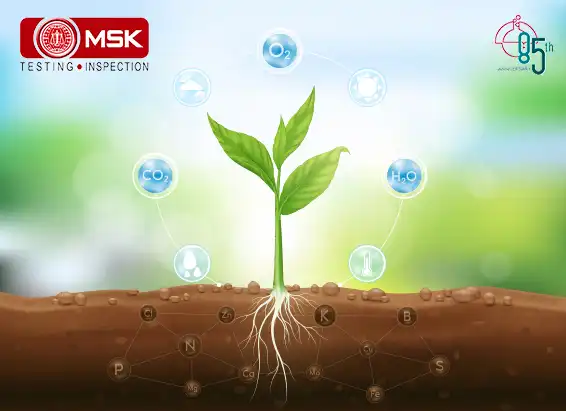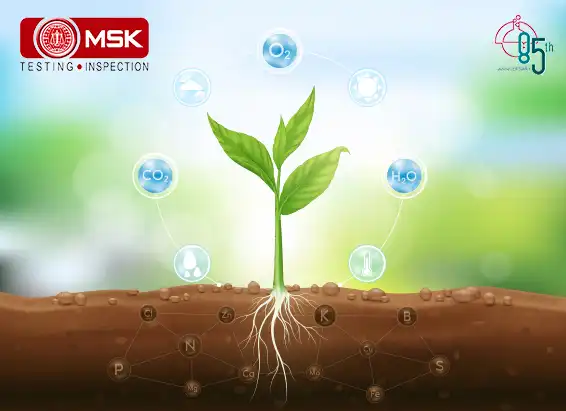
Central Laboratory, Mitra S. K. Private Limited
Red mud, the solid residue generated du…
Read More
Central Laboratory, Mitra S. K. Pvt. Ltd.
Ilmenite (FeTiO₃) is the primary titanium-b…
Read More
Immunomagnetic separation (IMS) is highly efficient techni…
Read More
Gingerol, the key bioactive molecule responsible for the pungency and therapeutic benefits of Zin…
Read More![Estimating Cobalt by UV-Vis Spectroscopy: The [CoCl?]²? Acetone Method](https://mitrask.com/uploads/blogs/1764834098Estimating%20Cobalt.png)
Central Laboratory, Mitra S. K. Private Limited
Central Laboratory, Mitra S. K. Private Limited

The food and beverage industry is constantly seeking ingredients that satisfy two core demands: n…
Read More
A seismic shift is underway in global trade, and it’s spelled CBAM. The European Union'…
Read More
In a world shifting toward sustainability, few sectors embody the principles of a circula…
Read More
With urb…
Read More
Ballast water plays a critical role in maintaining the stability and maneuverability of ships dur…
Read More
Biohydrometallurgy is a field that encompasses the overlapping areas of biology and hydrometallur…
Read More

In the dynamic landscape of natural products, precision and quality are key to s…
Read More
At Mitra S K Pvt Ltd, we understand the critical role that feed quality plays in…
Read More
An investigation to understand the efficacy of Xray Diffraction for the …
Read More
The activation of atmospheric CO2 and its chemical fixation as metal carbonate complexes are of c…
Read More
DRI is a premium ore-based metallic raw material made by removing chemically-bound oxygen fr…
Read More
Mr. Gaurav Kumar, Ms. Sudeshna Bhattacharya & Dr. Nandita Das

A boiler is an enclosed vessel, which is used to trans…
Read More
Mineral beneficiation[1] is the process of separating economically essential minerals from their …
Read More
Unlock Hidden Value in Your PCBs with Our Advanced Precious Metal Recovery Testing In 202…
Read More
Per- and polyfluoroalkyl substances (PFAS), commonly referred to as "forever che…
Read More
At Mitra S K Pvt Ltd, we are at the forefront of delivering ad…
Read More
PM100 typically refers to particulate matter with a diameter of 100 micrometres …
Read More
At Mitra S. K. Pvt. Ltd, we are continuously exploring innovative ways to utilize industrial by-p…
Read More
Spot emission measurement for a cement plant is a crucial …
Read More



Performance guarantee and performan…
Read More

Aquatic Flora and Fauna:

Introduction:
At Mitra S.K. Private. Limited. (MSK), we continually st…
Read More
In cold climates, transporting minerals like iron ore can pose significant challenges due to free…
Read More
GHGs directly trap heat and increase global warming but there is another concept that is becoming…
Read More
Introduction:
Silica (SiO2) is a highly abundant mineral fo…
Read More
Once a lithium-ion battery is retired, the batteries can be collected, fully discharged, then shr…
Read More
Abstract:
Both Cinnamomum zeylanicum (Ceylon Cinnamon, True C…
Read More
Introduction
Biogenic amines are basic nitr…
Read More

ABSTRACT
Proline is the predominant free amino acid of honey and it is…
Read More
Abstract:
Genetically modified organisms are produced by modifying or …
Read More
Introduction
Biogenic amines are basic nitrogenous compounds formed be…
Read More
INTRODUCTION
Acrylic acid vapours is primarily confined to production …
Read More
Abstract:
Loss of nutrient from conventional fertiliz…
Read More
Abstract:
Electronic waste or E-Waste describes discarded electrical o…
Read More

Introduction:
Activated carbon is a common term for a family of highly…
Read More
Introduction:
Fire assaying is an age-old technique which uses intense…
Read More
NPK fertilizers are a class of complex fertilizers that contain the elements nitrogen, phosphorou…
Read More
Introduction
Portland cement is a binder, a substance used f…
Read More
A brief discussion on Lead acid battery recycling and associated challenges Read More

Introduction
Phosphorus is a hazardous impurity (poison) in steel. Ste…
Read More
Keywords: Hydrocarbon, Solid Phase Extraction, Paraffin, Gas Chromatography…
Read More
Abstract:
Alpha-amylase is considered to be one of the primary enzymes…
Read More
Introduction
β – Carotene the precursor of Vitamin A is a r…
Read More
Introduction:
The bursting of crackers during in any occasion increase…
Read More
Abstract:
Anthocyanins are a type of pigment found in fruits that offe…
Read More
ABSTRACT
Black pepper (Piper nigrum) is a spice vine crop which is use…
Read More
Abstract:
The process of repeated frying of refined palm oil plays a s…
Read More
ABSTRACT:
Determination of Nitrate Nitrogen, Urea –Nitrogen and…
Read More
The protein digestibility-corrected amino acid score (…
Read More
Introduction:
Total carbon in the Biomass is comprised of two fraction…
Read More
Abstract:
This present work was aimed at the quantitative determinati…
Read More
Introduction:
The Ultraviolet spectrum has four wavelengths, these are…
Read More

Chief Operation, FAMD, Tata Steel Limited..


Sr. General Manager,, Emirates Trading Agency L.L.C..


Mines Manager, Hindustan Zinc Limited, a Vedanta Company.


General Manager, Stevin Rock L.L.C..


Executive Vice President (Works),, DCW Limited.


AVP – Coal Quality & Sales Compliance Head,, PT Indo Tambangraya Megah Tbk (BANPU).


Laboratory Head, MMX.


Shipping Administrator, Mount Gibson Iron Limited.


Senior Director – Asia Pacific Iron Ore Sales,, Cliffs Natural Resources Pty Ltd..


Member, Compass Group (India) Pvt. Ltd.

Posted on December 16 2025 By Mitra S.K ADMIN
Read More
Posted on December 16 2025 By Mitra S.K ADMIN

Posted on December 16 2025 By Mitra S.K ADMIN

Posted on December 11 2025 By Mitra S.K ADMIN
![Estimating Cobalt by UV-Vis Spectroscopy: The [CoCl?]²? Acetone Method](https://mitrask.com/uploads/blogs/1764834098Estimating%20Cobalt.png)
Posted on December 04 2025 By Mitra S.K ADMIN
Posted on December 04 2025 By Mitra S.K ADMIN

Posted on November 12 2025 By Mitra S.K ADMIN

Posted on September 23 2025 By Mitra S.K ADMIN

Posted on August 01 2025 By Mitra S.K ADMIN

Posted on July 25 2025 By Mitra S.K ADMIN

Posted on July 18 2025 By Mitra S.K ADMIN

Posted on July 01 2025 By Mitra S.K ADMIN

Posted on May 22 2025 By Mitra S.K ADMIN

Posted on January 24 2025 By Mitra S.K ADMIN

Posted on January 24 2025 By Mitra S.K ADMIN

Posted on December 31 2024 By Mitra S.K ADMIN

Posted on December 31 2024 By Mitra S.K ADMIN

Posted on December 31 2024 By Mitra S.K ADMIN

Posted on December 31 2024 By Mitra S.K ADMIN

Posted on December 31 2024 By Mitra S.K ADMIN

Posted on December 03 2024 By Mitra S.K ADMIN

Posted on October 17 2024 By Mitra S.K ADMIN

Posted on October 04 2024 By Mitra S.K ADMIN

Posted on September 13 2024 By Mitra S.K ADMIN

Posted on August 27 2024 By Mitra S.K ADMIN

Posted on August 23 2024 By Mitra S.K ADMIN

Posted on June 27 2024 By Mitra S.K ADMIN

Posted on June 22 2024 By Mitra S.K ADMIN

Posted on June 15 2024 By Mitra S.K ADMIN

Posted on May 24 2024 By Mitra S.K ADMIN

Posted on May 17 2024 By Mitra S.K ADMIN

Posted on May 09 2024 By Mitra S.K ADMIN

Posted on April 20 2024 By Mitra S.K ADMIN

Posted on April 13 2024 By Mitra S.K ADMIN

Posted on April 30 2024 By Mitra S.K ADMIN

Posted on April 29 2024 By Mitra S.K ADMIN

Posted on December 30 2023 By Mitra S.K ADMIN

Posted on December 30 2023 By Mitra S.K ADMIN

Posted on December 30 2023 By Mitra S.K ADMIN

Posted on December 27 2023 By Mitra S.K ADMIN

Posted on December 27 2023 By Mitra S.K ADMIN

Posted on December 27 2023 By Mitra S.K ADMIN

Posted on December 27 2023 By Mitra S.K ADMIN

Posted on December 27 2023 By Mitra S.K ADMIN

Posted on December 27 2023 By Mitra S.K ADMIN

Posted on December 27 2023 By Mitra S.K ADMIN

Posted on December 26 2023 By Mitra S.K ADMIN

Posted on April 05 2022 By Mitra S.K ADMIN

Posted on April 06 2022 By Mitra S.K ADMIN

Posted on April 06 2022 By Mitra S.K ADMIN

Posted on April 06 2022 By Mitra S.K ADMIN

Posted on April 06 2022 By Mitra S.K ADMIN

Posted on April 06 2022 By Mitra S.K ADMIN

Posted on April 06 2022 By Mitra S.K ADMIN

Posted on April 06 2022 By Mitra S.K ADMIN

Posted on April 06 2022 By Mitra S.K ADMIN

Posted on April 06 2022 By Mitra S.K ADMIN

Posted on April 06 2022 By Mitra S.K ADMIN

Posted on April 06 2022 By Mitra S.K ADMIN

Posted on April 06 2022 By Mitra S.K ADMIN

Posted on November 28 2022 By Mitra S.K ADMIN

Posted on April 06 2022 By Mitra S.K ADMIN

Posted on April 06 2022 By Mitra S.K ADMIN

Posted on April 06 2022 By Mitra S.K ADMIN

Posted on November 28 2022 By Mitra S.K ADMIN

Posted on June 14 2022 By Mitra S.K ADMIN






